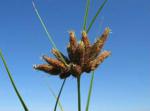Latin name
Scirpus maritimus L.
Family
Cyperaceae
Common name(s)
Saltmarsh bulrush
Synonym(s)
Bolboschoenus maritimus (L.) Palla (basionym), Schoenoplectus maritimus (L.) Lye (basionym), Scirpus fernaldii C. Bicknell, Scirpus maritimus var. cymosus (Rchb.) T. Koyama (accepted), S. maritimus L. var. fernaldii (C. Bicknell) Beetle, S. maritimus L. var. paludosus (A. Nelson) Kük., S. pacificus Britt., S. paludosus A. Nelson.
Geographical distribution
Asia: Korea.
South and Southeast Asia: Bangladesh, Cambodia, Indonesia, India, Lao PDR, Malaysia, Myanmar, Nepal, Pakistan, Philippines, Sri Lanka, Thailand and Vietnam.
Rest of the world: Germany, Greece, Hungary, Iran, Jordan, Kenya, New Zealand, Norway, Peru, Romania, Senegal, Soviet Union, Spain, Sudan, Suriname, Sweden, Tanzania, Turkey, Zambia, and Zimbabwe.
Morphology
A perennial sedge up to 180—cm—tall, with horizontally creeping rhizomes with hard ovoid tubers.
Stem: erect, arising from a tuberous base, slender to stout, 3—angled, smooth or rough to the touch and with fine longitudinal streaks.
Leaf: stiff and flat, margins are rough to the touch, without a ligule, upper ones overtopping the inflorescence; sheath smooth, tight and grayish brown in basal part.
Inflorescence: umbelliform with several unequal smooth primary rays, up to 10—cm—long, and short secondary rays; spikelets solitary or in clusters of 3—10, usually cylindrical but tapering toward the tip, and densely many flowered.
Nuts: obovate, 2—sided or 3—angled, brown to black and 2.5—4—mm—long.
Biology and ecology
Found in irrigated lowland rice fields and swampy areas. It can produce 265 tubers in 180 days and tubers can be found up to 30—cm below the soil surface.
Agricultural importance
An important weed of rice. Rice dry matter production can be reduced by almost 50% due to competition with S. maritimus.
Management
Cultural control: hand weeding, timely harrowings to desiccate the tubers, and practicing crop rotations.
Chemical control: Bentazon and applications of propanil and 2,4-D can effectively control this weed.
Selected references
Kern JH. 1974. Cyperaceae. Flora Malesiana Ser. 1 7(3): 435-753.
Lacsina RQ, De Datta SK. 1975. Integrated weed management practices for controlling a difficult weed in lowland rice. Philipp. Weed Sci. Bull. 2:1-10.
Lubigan RT, Mercado BL. 1974. Effect of different densities of Scirpus maritimus on yield of lowland rice. Philipp. Weed Sci. Bull. 1(2):60-63.
Moody K. 1989. Weeds reported in rice in South and Southeast Asia. Manila (Philippines): International Rice Research Institute. 442 p.
Moody K. 1992. Weeds of cropped areas in the Philippines. Philipp. J. Weed Sci. 19:31-78.
Paller EC Jr, Lubigan RT, Vega MR. 1971. Evaluation of phenoxy-propanil treatments for the control of Scirpus maritimus L. in lowland rice. Philipp. Agric. 55:225-231.
Visperas RM, Vergara BS. 1976. Autecology of Scirpus maritimus L. I. Growth characteristics and competition with rice. Philipp. Weed Sci. Bull. 3:1-14.
Contributors
JLA Catindig, RT Lubigan, and DE Johnson
